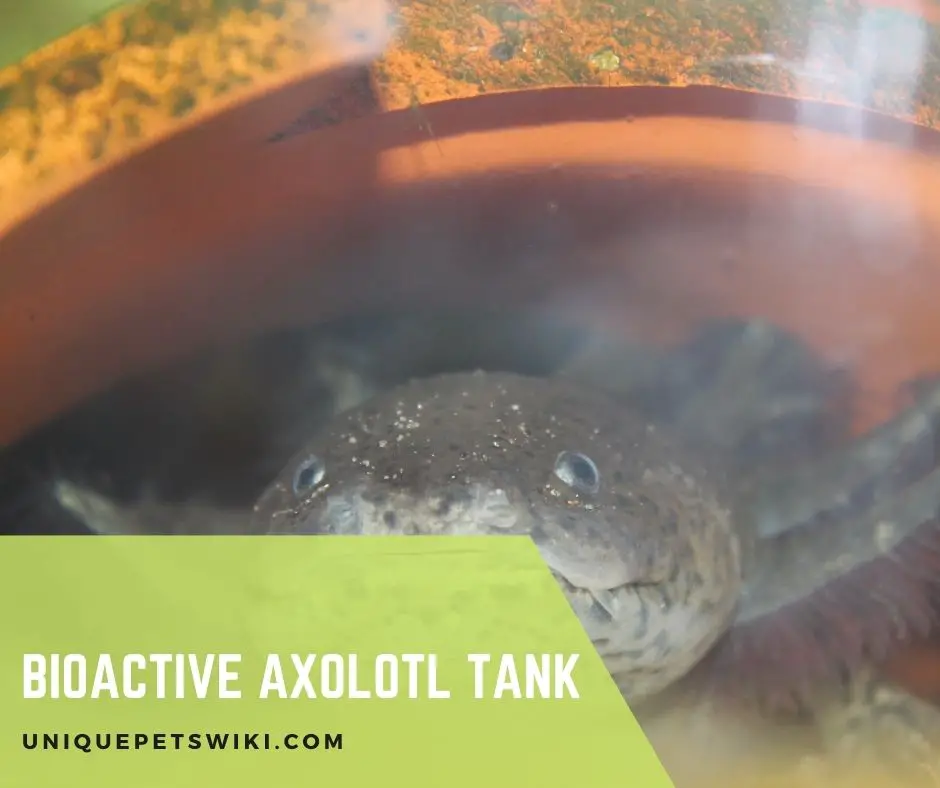A bioactive axolotl tank is a self-sustaining vivarium that can replicate an axolotl’s natural habitat found in Lake Xochimilco.
A bioactive axolotl tank has several benefits, the most important being that it needs very little daily maintenance.
For an axolotl, life in a small 20-gallon tank can be very different compared to the life it would live in its Mexican Lake with its wide variety of flora and fauna.
Replicating this biodiverse environment in a small aquarium is tricky but also doable.
In this guide, we will tell you everything you need to know about bioactive axolotl tanks.
Contents
What Is a Bioactive Tank?
A bioactive tank is a vivarium that creates a miniature ecosystem for your axolotl.
It consists of live plants, fungi, and microfauna that serve two purposes: they clean up waste by helping with the tank’s nitrogen cycle and also serve as food sources.
A successfully set up bioactive axolotl tank can help you go au naturale in that; you won’t have to do anything once it has been set up.
In fact; a bioactive tank needs to be cleaned once every 2-3 years! And there is virtually no daily upkeep needed.
A properly setup bioactive tank takes time and effort while an improperly set up one can be very harmful to your axolotls.
That is why the process needs a lot of careful planning and research.
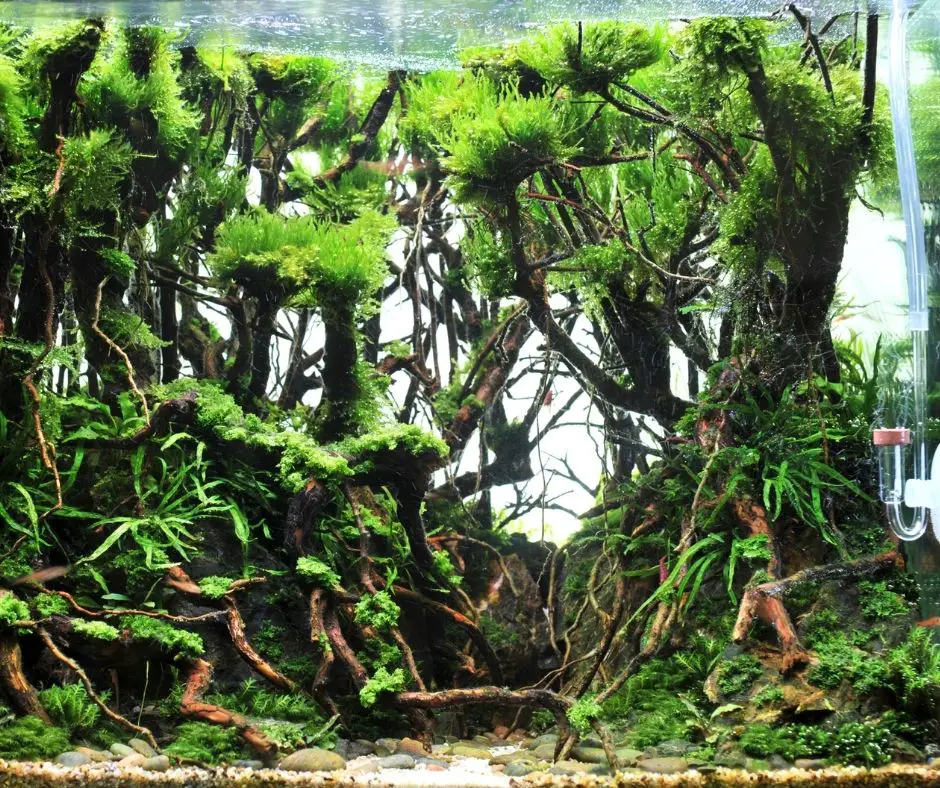
Benefits of Bioactive Axolotl Tank
There is absolutely no better way to house an axolotl other than a bioactive axolotl tank. Here are its benefits:
- Zero to Low Daily Maintenance
Once a bioactive axolotl tank is set up, it needs very little maintenance. You’d have to do very little daily cleaning other than wiping down the tank’s walls occasionally.
You need not make any water changes as the water is topped off automatically, and you need not feed the tank as all processes are automatic.
One need not even pick up their axolotl’s droppings since the beneficial microbes and detritivores convert this waste into beneficial nutrients for the tank’s live plants.
- Creates a Sustainable, Natural, and Healthy Environment for Your Axolotls
The most important benefit of a bioactive tank is that it closely resembles an axolotl’s natural habitat.
The tank provides optimum shelter and humidity to the inhabitants, cleans up waste, and converts it into beneficial nutrients, ensuring that your buddy thrives.
It provides a healthy environment so you needn’t worry about your pet’s wellbeing.
- Saves Time and Effort
Cleaning an axolotl’s tank can be tedious and sometimes, it is backbreaking work. Often, you need to scrub the filter or change it.
With a bioactive tank, regular maintenance and cleanup are all taken care of automatically. You will only need to clean the tank once every few years. Occasionally, you may have to wipe down the tank’s glass but that is all.
Imagine how much time and effort you’d be saving! Sometimes, you may have to travel for work leaving your pet with a well-meaning friend who might forget to feed it or make those water changes.
With a bioactive tank, all that is taken care of. The tank takes care of most of your pet’s daily needs. You can safely leave your axolotls alone for a few days without worrying about their wellbeing.
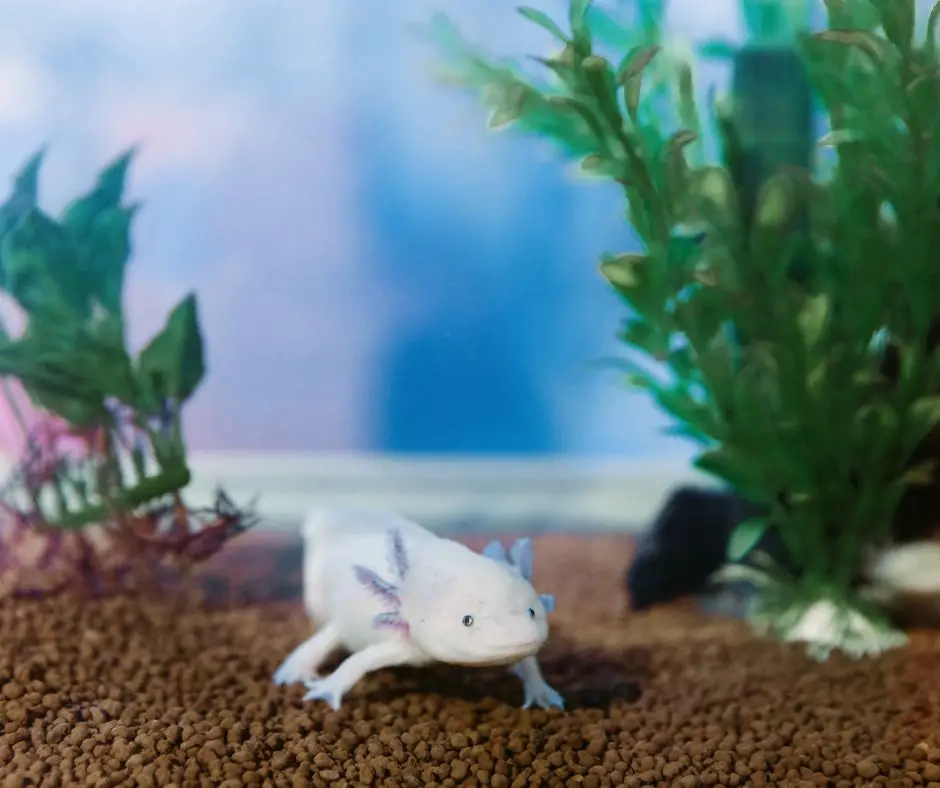
Is a Bioactive Tank Expensive?
Many people refrain from setting up a bioactive axolotl tank because they fear the expense would be high. In reality, you can easily set up a bioactive tank on a budget.
There are different types of vivariums and they all cost differently. So, you might spend anywhere between $100 and $1000 depending on what you add.
One thing to bear in mind is that a bioactive tank is a worthwhile investment. After all; you’d be saving a great deal in the longer run.
There will be a lesser need for water testing, cleanup, and fewer filter changes. You would save money on these things. Most importantly, your pet will thrive, so it means fewer vet bills as well.
In most cases, a bioactive tank for axolotls costs more or less the same as a regular tank.
The main thing is to add the right plants and tankmates for your axolotl. In a regular or normal tank, plants and tankmates are not mandatory. But for a bioactive environment, you need both of these elements.
Let us now check out the elements needed for a bioactive axolotl tank:
What Do You Need for a Bioactive Axolotl Tank?
The main elements of a bioactive axolotl tank are a sturdy tank of the right size with a canister filter, substrate, 24 x 7 low light, automatic feeder, plants, and mosses (Frogbit, Salvinia, java fern, bucephalandra, Anubias, etc.), and the right tank mates (snails, shrimp, and guppies).
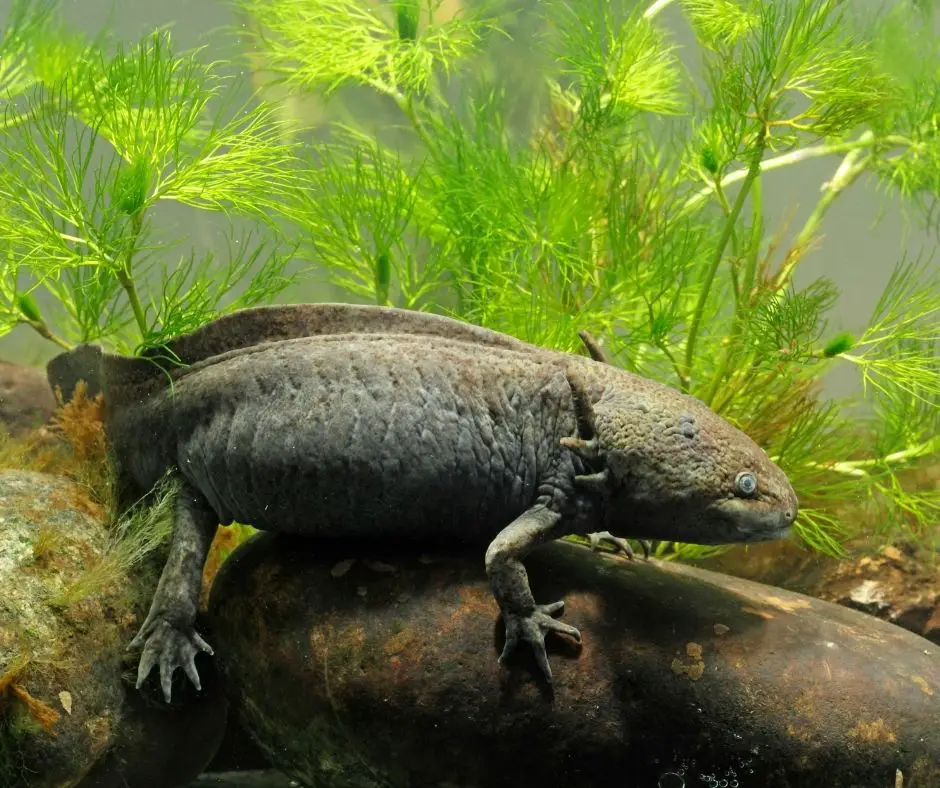
The Tank
If you plan to keep just one axolotl, you need a tank size of at least 20-gallons. If you house two or more axolotls, then you need a tank of 70-100 gallons.
It is always better to use a long tank instead of a tall or high tank. This will give your axolotls adequate room to swim.
When you buy the tank, clean it thoroughly to remove any dirt.
Aqueon Aquarium 20 Gallon Long
- High quality glass construction with dimensions 30.25" x 12.5" x 12.75"
- For freshwater and marine applications
- Clean silicone edges (select sizes available in clear or black)
- Always include a drip loop when plugging aquarium appliances into the electrical outlet
- Place aquarium on stand able to safely bear the weight of a filled aquarium
Last update on 2022-12-29 / Affiliate links / Images from Amazon Product Advertising API
The Substrate
A good substrate for axolotls is mineral-rich sand with large gravel that can provide a firm rooting system for the plants. It should also create an environment for beneficial bacteria to thrive.
Ensure that the sand is not too palatable for your axolotls – especially juveniles – as they could eat it and suffer impaction.
Check out our guide on the best axolotl substrate.
Toney River White Aquatic Sand Freshwater – 5-Pound Bag
- Contains one (1) API FRESHWATER MASTER TEST KIT 800-Test Freshwater Aquarium Water Master Test Kit, including 7 bottles of testing solutions, 1 color card and 4 glass tubes with cap
- Helps monitor water quality and prevent invisible water problems that can be harmful to fish and cause fish loss
- Accurately monitors 5 most vital water parameters levels in freshwater aquariums: pH, high range pH, ammonia, nitrite, nitrate
- Designed for use in freshwater aquariums only
- Use for weekly monitoring and when water or fish problems appear
Last update on 2022-12-30 / Affiliate links / Images from Amazon Product Advertising API
The Water
The main difference between a regular tank and a bioactive tank is that you won’t be performing any water changes for days in the bioactive tank. That makes it very important to use treated and conditioned water.
The water should be able to maintain the right pH, temperature, and salinity. It is a good idea to invest in a high-quality and reliable water testing kit to maintain optimum water parameters.
The Plants
A bioactive axolotl tank is self-sustaining, which is why it needs plenty of plants that will do all the hard work for you.
Plants lessen the need for making daily water changes. They aid the tank’s nitrogen cycle and convert waste matter into beneficial nutrients. That’s why your bioactive tank should be full of plants.
You can consider plants from paludairum. A paludarium is a vivarium that incorporates both land and water features. In short: consider those plants that grow in the swamp.
Some grow immersed, while others are floating plants. Floating plants are very efficient in converting toxins into green waste that you easily throw out.
The Filter
A filter will remove waste and toxins that are created in the tank. It also creates bubbles and oxygen for all the tank inhabitants. Choose a filter that is of the right size for the tank you choose.
We have covered the topic in detail in our guide on the best water filter for axolotl.
AquaClear 50 Power Filter
- Aquarium filtration system that offers superior contact time with filter media and energy efficient pump lowers operating costs
- Quick and easy installation; we recommend that you clean aquarium filter every 2 weeks for maximum operation and efficiency
- Provides optimal mechanical; chemical; and biological filtration
- Comes equipped with AquaClear Foam; Activated Carbon Filter and BioMax and Cycle Guard for superior water quality
- Filtration volume is up to 7 times larger than comparable fish tank filters
Last update on 2022-12-30 / Affiliate links / Images from Amazon Product Advertising API
The Decor
The decor elements add natural beauty to your bioactive axolotl tank. They also help the tank resemble your axolotl’s natural habitat.
You can add driftwood, pieces of the reef, and rocks to the tank. Make sure you boil everything to disinfect and sanitize it first. Choose the elements that won’t rust or harm your pet.
The Tankmates
Axolotls do very well on their own. But when it comes to creating a bioactive environment, you need some tankmates for it.
Tankmates like nitrite snails, daphnia, Amano shrimp, and micro-planarians clean up waste and bacteria.
For more information on the best tankmates for axolotls, click here.
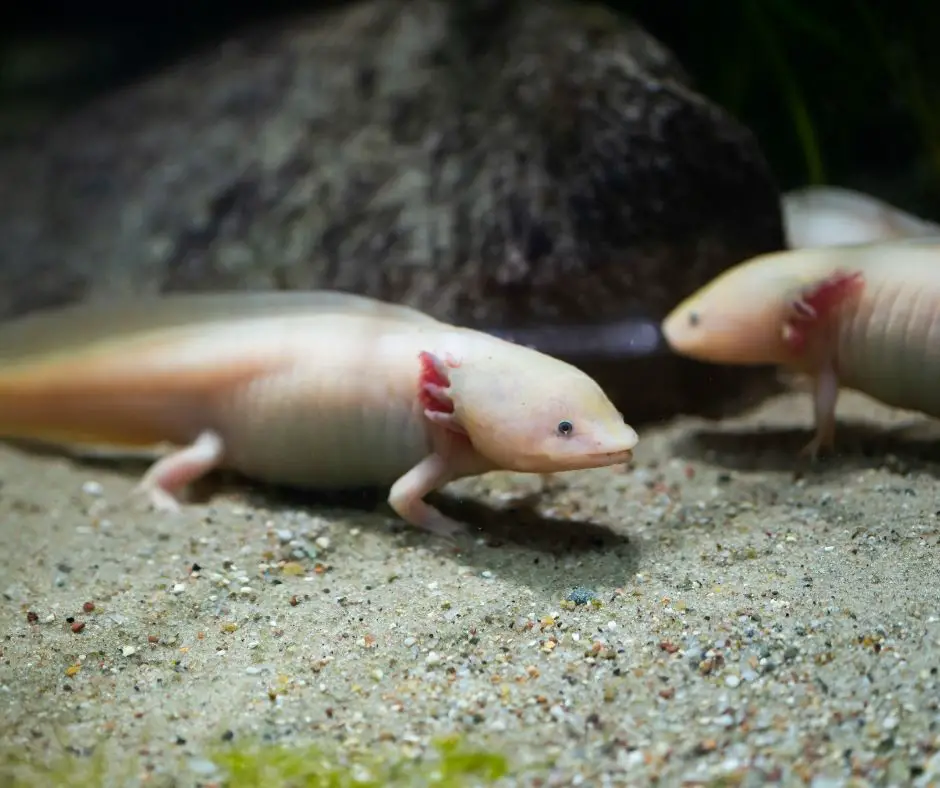
How to Setup Bioactive Axolotl Tank
Once you have all the items, it is time to set up the tank. Please take great care and follow each step accurately. Failure to do that means it might take longer to get the tank established.
Create the Ecosystem
An ecosystem will help the tank resemble the axolotl’s natural habitat closely. The following steps are given for a 20-gallon tank.
Step 1 – Add the Substrate
- You can use substrates such as topsoil or any generic garden variety soil with compost. Filter the compost out to remove twigs, stones, etc.
- If you are using sand or gravel, wash it thoroughly before adding it to the tank. To wash the sand, soak it in water overnight. This will remove any insects and impurities.
- Change the water the next morning and check if there are still other impurities. If not, the sand or gravel is ready to be added to the tank.
- Add at least 1-1.5 inches of topsoil to the clean tank. You can create a sloping effect by adding 1 inch of topsoil in the front and gradually increasing it to 1.5 inches at the back.
- Next, add 1-inch of gravel over the topsoil. The key is to not smother the sand with gravel but simply add enough to just cover it. This will help oxygenate the soil and yet prevent it from leaching into the water once you fill up the tank.
- Once your substrate and gravel are in place, gently add 3 inches of conditioned water to the tank. It is important not to disturb the soil too much as the tank fills up. Use a small twig to remove air bubbles in the sand as this will help ensure that sand does not leach into the soil.
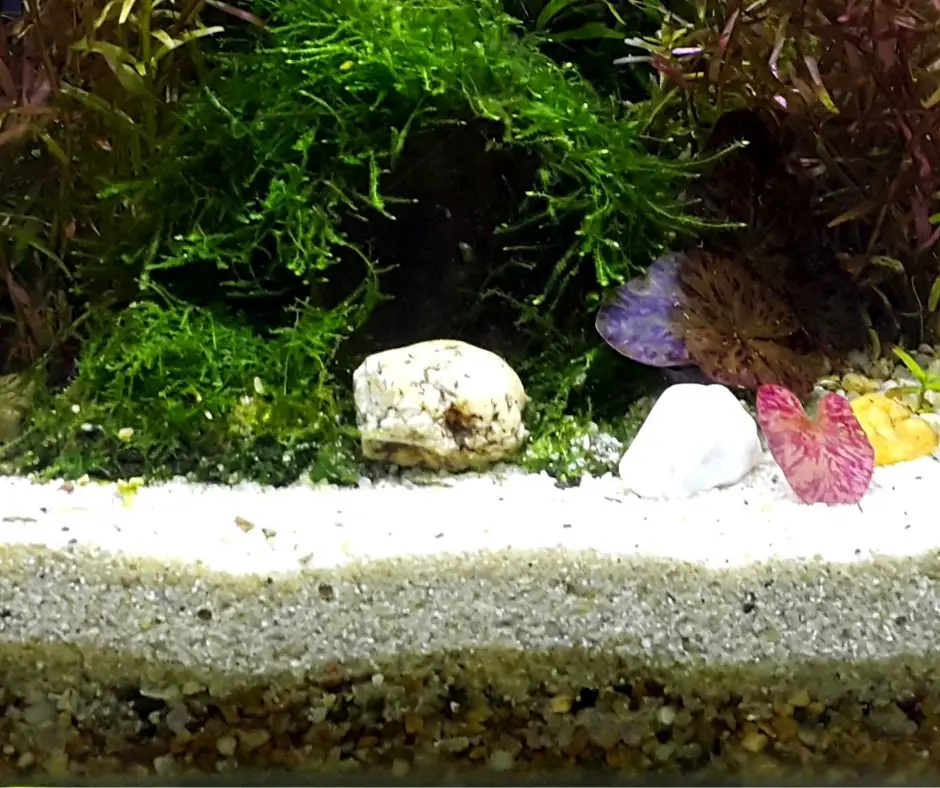
Step 2- Add Plants
Your plants are the bio-filter of your self-sustaining axolotl tank. So, make sure you have plenty of them. Plants that grow fast like stem plants and floating plants are great choices such as:
- Egeria Densa
- Alternanthera Lilacina
- Moss – Java Moss, Subswassertang
- Rotala Ceylon
- Ludwigia Natans Super Red
- Ludwigia arcuata
- Ludwigia Sedioides
- Water lettuce
- Salvinia cucullata
- Salvinia natans/ Floating Fern
- Floating Christmas Moss Ball
- Duckweed
- Amazon Frogbit
- Azolla filiculoides
- Ceratopteris Cornuta
- Round Pellia.
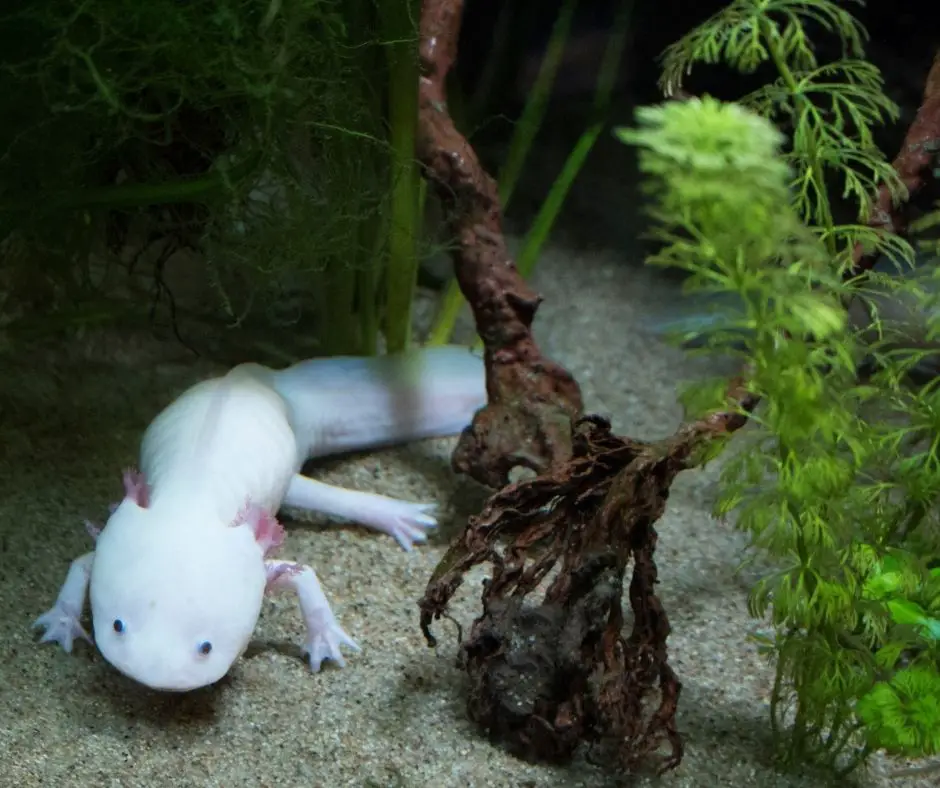
These plants grow fast and also convert waste into nutrients. Remember: plants will only help your bioactive tank if they themselves thrive.
And for your tank’s plants to thrive, pay careful attention to the light, water, and temperature.
Since axolotls need slightly cool water, you may also want to plant cold water plants for axolotls.
You can find these plants online, at local pet stores, or even from other aquarium owners.
- When adding the plants, keep some kind of aquascape in your mind. This way, plants with larger leaves won’t block the smaller ones. Try placing the larger leaf plants at the back of the tank. The stem plants can go in the front of the tank.
- If you are adding decor elements like rocks and driftwoods, you can tie rhizomes and mosses to them.
- Never let rhizome plants grow under the substrate as they could rot. Use a pair of tweezers to plant the roots of the plants firmly in the substrate. The roots should be deep enough to not uproot once you add the water.
Hygger Long Stainless Steel Premium Aquarium Tools
Step 3: Add Conditioned Water
- Once your plants are in place, you can slowly fill up the tank with conditioned water. Take care not to disturb the substrate as the tank fills up. If any plants get loosened during the process of filling, use tweezers to gently push them back.
- On the first day, the water will be cloudy and have bits of debris floating in it. Remove the debris and wait 24 hours for the water to clear up.
- If the water is not clear after 24 hours, make sure that sand is not leaching into it. If it is, the water might also get darkish in color due to the tannins. Wait for 24 hours more. If the water is still unclear after 48 hours, make a water change.
- In rare cases, you might have to empty the entire tank and start over again by adding substrate and plants and then filling up with water again.
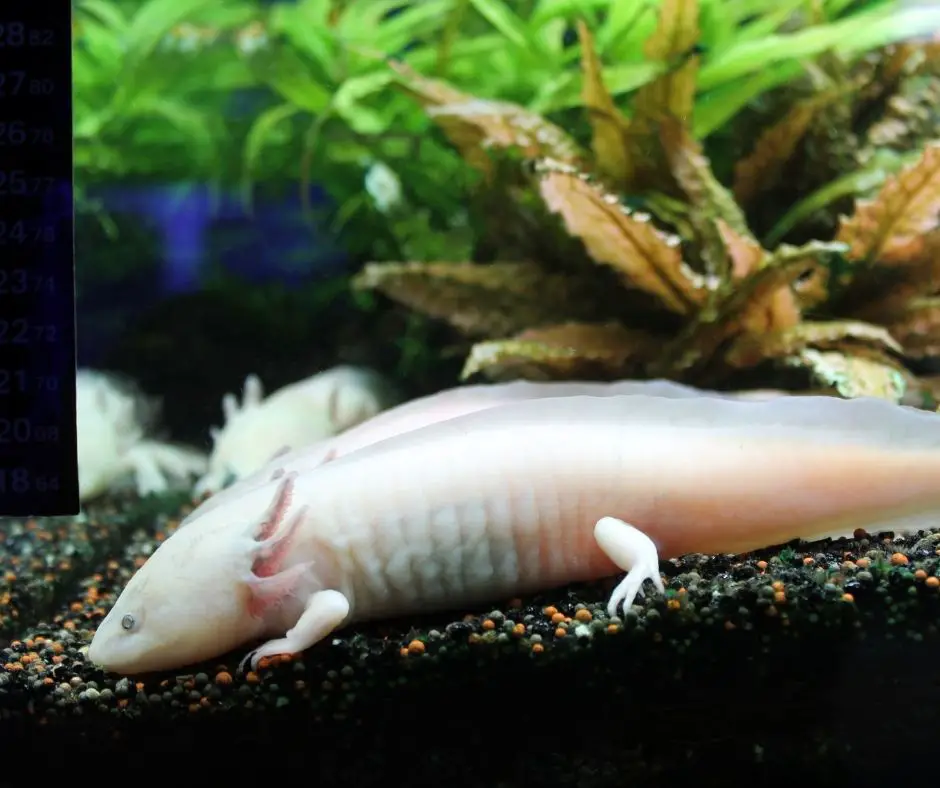
Step 4: Add Aquarium Components and Micro-Filters
- Once the water is completely clear, add nitrite snails, daphnia, micro-planarians, and Amano shrimp.
- These will help kick start the nitrogen cycle and convert waste into useful bacteria. Some of these inhabitants will need food at some point. Feed them algae wafers, pelleted food, or shrimp. Add some fish food as a source of ammonia. This will further kickstart the nitrogen cycle.
- Wait for 12-24 hours and test the water parameters. The nitrogen cycle should start at this point.
- Once it has started, you need to make 25% water changes every 3-4 days. You can also add in a water filter at this point.
API FILSTAR XP MICROFILTRATION Aquarium Canister Filter
- Contains one (1) API FILSTAR XP MICROFILTRATION Aquarium Canister Filter Filtration Pads 3-Count
- Ideal to filter finest particles in combination with thicker foam pads.
- Designed to fit API FILSTAR xP canisters filters.
- For use in freshwater and saltwater aquariums.
- Replace every time water is changed or at least once a month.
Last update on 2022-12-29 / Affiliate links / Images from Amazon Product Advertising API
Step 5: Add the Axolotl
- The nitrogen cycle will take at least 4 weeks to get properly established, so be patient. Test the water regularly and continue making water changes.
- Once the parameters show that the nitrogen cycle has properly been established, you can add your axolotl to the tank. Don’t forget to ensure that the tank water is between 16-18 deg C or 60-64 F.
- If needed, use an aquarium chiller to keep the water at this temperature.
- To acclimatize your axolotl to the new tank, float its bag (without opening) into the new tank. This will bring the water in the bag at the same temperature as the tank water. Let your pet sit in the bag inside the newly cycled tank for at least 1 hour before releasing it into the tank.
Ensuring that the Bioactive Axolotl Tank is Functional
A Bioactive tank has a lot of chemistry going inside it. So you must test the water parameters regularly.
Any changes in water parameters could disturb the food chain and ecosystem inside the tank. Your axolotls will be eating and creating waste in the tank.
The waste should be taken up by the snails, shrimp, and micro-planarians and converted into useful microbes.
Keep checking the tank’s parameters every day. You do not have to do anything else. As long as your axolotl is thriving and the parameters are fine, you can say that your bioactive tank has been successfully established.
API FRESHWATER MASTER TEST KIT 800-Test
- Contains one (1) API FRESHWATER MASTER TEST KIT 800-Test Freshwater Aquarium Water Master Test Kit, including 7 bottles of testing solutions, 1 color card and 4 glass tubes with cap
- Helps monitor water quality and prevent invisible water problems that can be harmful to fish and cause fish loss
- Accurately monitors 5 most vital water parameters levels in freshwater aquariums: pH, high range pH, ammonia, nitrite, nitrate
- Designed for use in freshwater aquariums only
- Use for weekly monitoring and when water or fish problems appear
Last update on 2022-12-30 / Affiliate links / Images from Amazon Product Advertising API
Maintaining Your Tank
- On a monthly basis, make 25% water changes and clean out the filter.
- Trim any overgrown plants. Grab and toss floating plants every couple of weeks in the tank.
- Scrape the tank’s glass walls.
- Adjust light requirements – avoid bright lights as they are stressful for your axolotls and also encourage algae growth.
- Test water parameters regularly. You do not want any imbalances in ammonia, nitrates, and nitrites.
- Top off the water since you lose water at the surface due to evaporation.
Can You Keep an Axolotl without a Bioactive Tank?
Yes, you can keep an axolotl in a non-bioactive/regular tank. However, you still need a cycled tank meaning that the tank should have its nitrogen cycle established with ammonia and nitrites at 0 ppm and nitrates < 40 ppm.
Do note that keeping an axolotl without a bioactive tank means you need to keep checking the water parameters regularly. Without this, the levels of ammonia could rise dangerously leading to axolotl’s death.
You also need to be proactive with tank maintenance. You will have to clean the tank, make regular water changes, and feed your pet every few days.
In short: a cycled tank is also an option for housing an axolotl but with a cycled tank, there is a lot more maintenance involved. With a bioactive tank, a lot of these things are taken care of naturally, and there is definitely a lot less maintenance to deal with.
Tetra ColorFusion Aquarium 20 Gallon Fish Tank Kit
- Let the LED light transform your aquarium with each color change. Pause the cycle on any color to fully customize your aquarium
- The anemones sway with your filter current and give your fish a place to hide and relax
- Tetra plants come to life under the glow of Color Fusion LED
- The Tetra ColorFusion Kit includes: one 20 Glass gallon Aquarium, one aquarium hood, one UL Heater, one Tetra Whisper 20 Filter, one Color Fusion Universal Color Changing LED, two Wonderland Plant Multipacks, one Blooming White Anemone
- Aquarium Dimensions:24.2" L x 12.4" W x 16.7" H
Last update on 2022-12-29 / Affiliate links / Images from Amazon Product Advertising API
Our Personal Take on Bioactive Axolotl Tanks
In Lake Xochilimco where axolotls come from, annual rainfall and water runoff take care of water changes and add minerals and trace minerals to the water.
The natural flora and fauna further aid the nitrogen cycle ensuring that the axolotls thrive.
In a bioactive tank, human intervention is still needed to ensure optimum water parameters. After all; it is a closed system and the tank inhabitants are counting on us to maintain their ecosystem.
Water changes are still needed to remove the waste from the tank and also add trace minerals and minerals to the tank.
In short: there is no such thing as a zero maintenance tank. A bioactive tank is a great way to house an axolotl but maintenance is still required.
The great thing with such self-sustainable tanks is that the frequency of cleaning and maintenance is drastically reduced.
You can also leave your pet home alone for a couple of days and not worry about feeding it or making water changes.
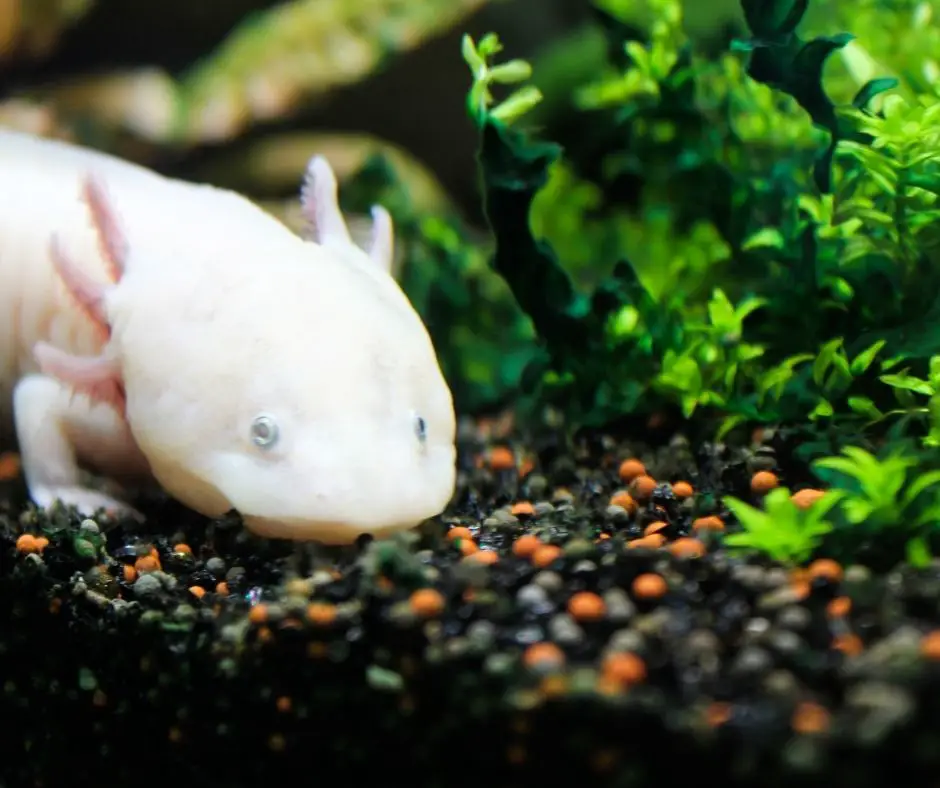
FAQs
Can you keep axolotl in a planted tank?
Yes, you can keep axolotl in the planted tank provided the plants you select prefer low temperatures and low light.
Good plants for axolotls include Java fern, duckweed, Anubis, and Christmas moss.
What can I put in my axolotl tank?
Your axolotl will need a filter, some cold water plants, and decorations like driftwood, rocks, and rust-proof pipes.
You can also add some beneficial tank mates like shrimp, snails, etc.
Can I put bamboo in my axolotl tank?
Dracaena sanderiana or Lucky bamboo is safe to add to an axolotl’s aquarium.
However, regular bamboo will rot and decay in the water, so it is best not to add it to the axolotl’s tank.
Wrapping Up – Bioactive Axolotl Tank
A bioactive axolotl tank is a self-sustaining vivarium that can help your axolotl thrive. It contains an ecosystem that closely resembles the axolotl’s natural habitat.
It uses plants that absorb waste and help maintain optimum ammonia, nitrates, and nitrites. Bioactive axolotl tanks require very little cleaning and maintenance.
We hope this guide helps you start and maintain a bioactive axolotl tank successfully.
